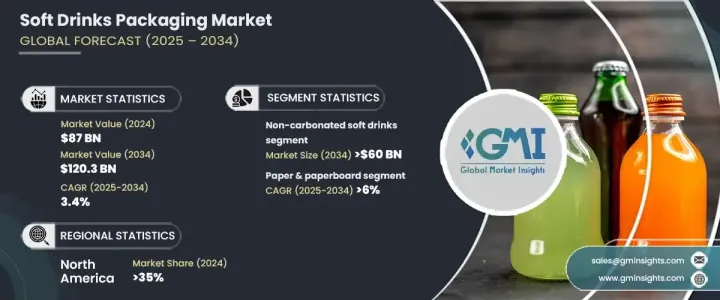
세계의 청량음료 포장 시장은 2024년 870억 달러에 달했고, 2025년부터 2034년까지 연평균 복합 성장률(CAGR) 3.4%로 성장할 것으로 예측됩니다.
이러한 꾸준한 성장은 소비자 선호 변화 및 규제 압력, 특히 지속 가능한 포장 솔루션에 대한 수요 증가에 대한 이 분야의 역동적인 대응을 반영합니다. 환경 문제에 대한 의식이 높아짐에 따라 브랜드와 소비자는 친환경적인 대체 포장에 끌려 업계의 혁신적인 변화를 보여줍니다. 이러한 대체품 중에서도 종이 기반 포장은 재활용 가능하고 환경 실적가 적기 때문에 플라스틱을 대체할 수 있는 대체품으로 주목받고 있습니다. 폐기물의 최소화를 목표로 하는 세계의 노력이 침투하는 가운데, 종이 포장의 채용은 향후 10년간 시장 확대에 있어 매우 중요한 역할을 할 것으로 예상됩니다. 게다가 기술의 첨단화와 혁신적인 포장 디자인은 지속가능성에 대한 헌신을 유지하면서 브랜드가 시장에서 호소력을 강화할 수 있는 새로운 기회를 창출하고 있습니다.

시장은 음료 유형에 따라 탄산 음료와 비탄산 음료로 구분됩니다. 비탄산 청량음료 분야는 보다 건강하고 자연적인 음료 옵션에 대한 수요가 증가함에 따라 2034년까지 600억 달러를 창출할 것으로 예측됩니다. 과일 주스, 아이스 티, 병물, 스포츠 음료와 같은 비 탄산 음료는 높은 당분과 인공 성분을 포함하는 경우가 많은 탄산 음료의 훌륭한 대안으로 간주됩니다. 이러한 자연스럽고 건강 지향적 인 음료로 소비자의 변화는 시장 상황을 변화시키고 혁신적이고 지속 가능한 포장 솔루션에 대한 수요를 더욱 높이고 있습니다.
| 시장 범위 | |
|---|---|
| 시작 연도 | 2024년 |
| 예측 연도 | 2025-2034년 |
| 시작 금액 | 870억 달러 |
| 예측 금액 | 1,203억 달러 |
| CAGR | 3.4% |
재료별로는 유리, 금속, 종이, 판지, 플라스틱, 기타 재료가 있습니다. 종이 및 판지 분야는 2025년부터 2034년까지 CAGR 6%라는 강력한 성장이 전망되고 있으며, 가장 급성장하고 있는 카테고리입니다. 지속 가능한 옵션을 요구하는 수요로 인해 일회용 플라스틱에서 생분해성이 뛰어나고 친환경적인 종이 기반 솔루션으로의 전환이 가속화되고 있습니다. 플라스틱 폐기물에 관한 세계의 규제가 강화되고 환경에 대한 의식이 높아짐에 따라 브랜드는 소비자의 기대와 규제 기준을 충족하기 위해 종이 패키지를 선택하게 되었습니다.
2024년에는 북미가 세계 청량음료 포장 시장의 35% 점유율을 차지하고 미국이 이 지역 성장의 선두였습니다. 미국 시장을 견인하는 것은 편의성과 친환경적인 포장에 대한 소비자 선호 증가입니다. Ready-to-Drink 음료가 계속 선반을 석권하고 있기 때문에 제조업체는 재활용 가능하고 최소한의 패키지 디자인에 투자하도록 촉구하고 있습니다. 게다가 정부의 엄격한 정책과 지속가능성에 대한 소비자의 의식이 높아지면서 각 브랜드에 친환경적인 관행을 채택하고 있으며 이 분야의 지속적인 성장과 혁신을 확실히 하고 있습니다.
The Global Soft Drinks Packaging Market reached USD 87 billion in 2024 and is projected to grow at a CAGR of 3.4% from 2025 to 2034. This steady growth reflects the sector's dynamic response to shifting consumer preferences and regulatory pressures, particularly the heightened demand for sustainable packaging solutions. As awareness of environmental issues rises, brands and consumers alike are gravitating towards eco-friendly packaging alternatives, signaling a transformative shift in the industry. Among these alternatives, paper-based packaging is emerging as a frontrunner, offering a viable substitute for plastic due to its recyclability and reduced environmental footprint. With global initiatives aimed at minimizing waste gaining traction, the adoption of paper packaging is expected to play a pivotal role in the market's expansion over the next decade. Furthermore, technological advancements and innovative packaging designs are creating new opportunities for brands to enhance their market appeal while maintaining a commitment to sustainability.

The market is segmented by type of drink into carbonated soft drinks and non-carbonated soft drinks. The non-carbonated soft drinks segment is projected to generate USD 60 billion by 2034, driven by an increasing demand for healthier, more natural beverage options. Non-carbonated drinks, such as fruit juices, iced teas, bottled water, and sports drinks, are viewed as superior alternatives to carbonated soft drinks, which often contain high sugar content and artificial ingredients. This consumer shift towards natural and health-oriented beverages is reshaping the market landscape, further boosting the demand for innovative and sustainable packaging solutions.
| Market Scope | |
|---|---|
| Start Year | 2024 |
| Forecast Year | 2025-2034 |
| Start Value | $ 87 Billion |
| Forecast Value | $120.3 Billion |
| CAGR | 3.4% |
By material, the market encompasses glass, metal, paper and paperboard, plastic, and other materials. The paper and paperboard segment is poised to grow at a robust CAGR of 6% between 2025 and 2034, making it the fastest-growing category. The demand for sustainable options is accelerating the shift from single-use plastics to paper-based solutions, which are seen as biodegradable and more environmentally responsible. As global regulations tighten around plastic waste and environmental awareness intensifies, brands are increasingly opting for paper packaging to meet consumer expectations and regulatory standards.
In 2024, North America held a 35% share of the global soft drinks packaging market, with the United States spearheading regional growth. The US market is driven by rising consumer preferences for convenience and eco-friendly packaging. Ready-to-drink beverages continue to dominate the shelves, prompting manufacturers to invest in recyclable and minimalist packaging designs. Furthermore, stringent government policies and growing consumer consciousness about sustainability are compelling brands to adopt greener practices, ensuring continued growth and innovation in this segment.